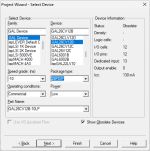cj7hawk
Veteran Member
Hi All,
Just wondering what GAL compilers are still around... At the moment I'm using GALASM, but that only runs under Linux so I run WSL to use it. Are there any Windows native compilers anymore, and any that can program the GAL22V10? Also would love to find a compiler for the GAL26V12 - I've always wanted to try using them... And speaking of which, are there any programmers that do the 26v12?
Just wondering what GAL compilers are still around... At the moment I'm using GALASM, but that only runs under Linux so I run WSL to use it. Are there any Windows native compilers anymore, and any that can program the GAL22V10? Also would love to find a compiler for the GAL26V12 - I've always wanted to try using them... And speaking of which, are there any programmers that do the 26v12?

